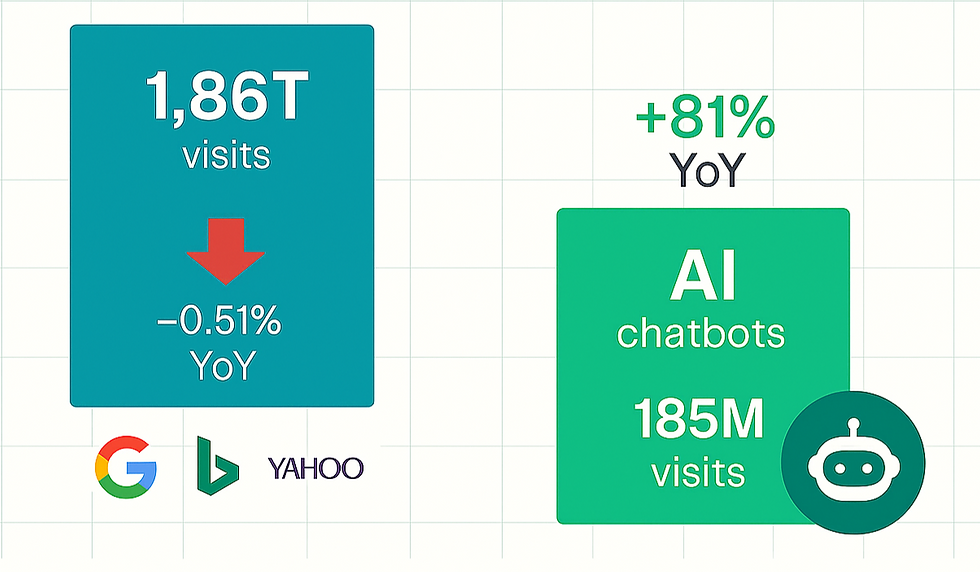Global Web Traffic Shift: Search Engines vs. AI Chatbots
- Graziano Stefanelli
- Jun 16
- 4 min read

Rapid Growth of AI Chatbots
From April 2023 to March 2025, AI chatbot traffic has surged dramatically. Specifically, the total visits to the ten leading AI chatbot platforms have increased from around 30.5 billion to over 55.2 billion—an impressive growth rate of 81%. Platforms such as ChatGPT, Claude, DeepSeek, Grok, and Microsoft's Copilot have experienced explosive user adoption, highlighting a significant change in user search and information retrieval behaviors.

Search Engines Maintain Dominance but Face Declines
Traditional search engines like Google, Bing, and Yahoo still command vastly higher traffic, totaling about 1.86 trillion visits. Nevertheless, their growth has stagnated, even declining slightly (-0.51%) year-over-year. Google remains the dominant platform, averaging roughly 4.7 billion daily visits, whereas ChatGPT, the leading AI chatbot, attracts approximately 185 million daily visits, illustrating that search engines still have a stronghold but face growing competition from AI alternatives.
•••
Google is still the world’s biggest search engine, but even it lost a small amount of traffic this year. Its visits dropped by about 1.4%, which is unusual for Google. To stop losing more users, Google has added more AI-powered answers (using its Gemini system) to search results. Now, people often see the answer to their question right at the top of the page, so they don’t have to click any links.
Microsoft Bing was the only big search engine to gain more users this year. This happened because Microsoft put its Copilot AI directly into the Bing homepage, the Edge browser, and Windows 11. Many people, especially at work, are now using Bing without even choosing it—it’s just built into their computers.
Yandex, the main search engine in Russia, grew a lot because it released a new “Neural Search” feature. Naver, the top search engine in South Korea, also gained more users thanks to AI improvements in Korean-language search.
Yahoo lost users quickly because it was slow to add AI features, and many of its old users moved to other services.
DuckDuckGo and Ecosia are smaller, but they’re experimenting with unique features. DuckDuckGo now has a private AI answer box, while Ecosia plants trees for every search done with its AI answers. Ecosia is growing fastest among these smaller search engines.
Because search engines now answer more questions directly, news websites and publishers are worried about losing visitors. Some news sites are making it harder for chatbots to copy their new stories or changing their headlines so bots can’t use them easily.
A new problem for websites is called “unattributed knowledge leaks.” This means chatbots give users answers based on information from news sites, but those users never visit the actual site. As a result, publishers can’t earn money or count their audience from those answers.
Emerging User Behavior Trends and the Problematic Impact
A significant behavioral shift has emerged, with more users increasingly seeking direct answers from AI chatbots rather than relying on traditional search engines. Approximately 80% of users now resolve nearly 40% of their online queries directly through chatbots, bypassing websites entirely. This problematic trend presents serious implications for publishers, marketers, and content creators who rely on organic traffic from search engines. The shift reduces overall click-through rates and diminishes the ability to measure and analyze user behavior through traditional analytics tools.
Problematic Issues Facing Marketers and Publishers
Reduced Organic Traffic and Visibility
With AI platforms offering instant answers, fewer users click through to websites, significantly decreasing referral traffic. Publishers and businesses reliant on traffic-driven revenue, such as advertising and subscriptions, face a problematic decrease in income.
Fragmentation of Audience Attention
The rapid emergence and adoption of numerous AI chatbot platforms like Grok and DeepSeek fragment audience attention. Businesses must now track visibility and optimize for multiple AI-driven platforms, increasing complexity and the resources required for content strategy and audience engagement.
Changing SEO Landscape
The rise of AI chatbots complicates traditional search engine optimization (SEO). Businesses must shift from traditional SEO methods to Answer Engine Optimization (AEO) and Large Language Model SEO (LLM-SEO), requiring a substantial investment in new technical expertise and content restructuring.
Industry Responses and Strategic Implications
Leading search engines, recognizing the threat, are integrating AI-driven answers directly into search results pages, aiming to retain users within their ecosystems. This approach exacerbates the problematic issue of declining referral traffic for third-party websites. Consequently, industry stakeholders are increasingly advocating for fair attribution methods, transparent algorithms, and equitable traffic-sharing agreements.
Recommended Actions for Businesses and Marketers
To address these problematic issues effectively, businesses and marketers should:
Audit and adapt existing content to ensure visibility within AI-driven answers, emphasizing structured and concise information.
Implement multi-platform visibility strategies by actively engaging with emerging AI chatbots, ensuring content relevance and discoverability.
Invest in new optimization techniques including AEO and LLM-SEO, focusing on direct-answer formats, clear content structures, and enhanced technical capabilities.
Monitor and analyze evolving user behavior through advanced analytics and engagement metrics to stay ahead of shifts in search and content consumption patterns.
________
FOLLOW US FOR MORE.
DATA STUDIOS




